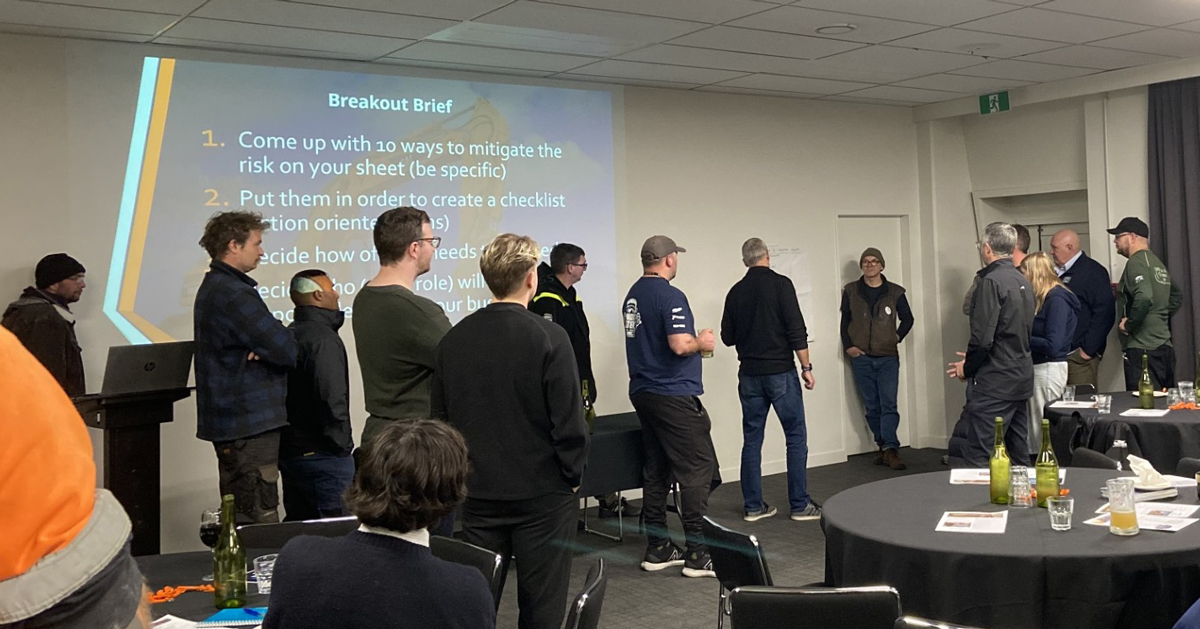How to manage risks – part II
28 Jul 2025, Employer Tips, Income, Insurance Tips, You

At the recent PlaceMakers LBP seminars in Wellington and Napier, construction risk and insurance expert Ben Rickard, from Builtin Insurance Brokers, invited attendees to come up with ways to eliminate, reduce or manage the top five risks they might face in their businesses (according to builders).
Under Construction has previously covered the top two risks builders said they faced – managing cashflow and personal illness or injury. You can read that by clicking this link.
Risk 3 – Retaining staff
The cost of fluctuating staff availability, reliability and competence was listed as the third largest risk that business owners face.
According to the stats, roughly one in eight workers leaves a small construction business every three months. Mental health-related absenteeism is rising, with small businesses reporting a 20% increase in mental-health absences year-on-year.
Replacing an employee can cost between 50-200% of their annual wage, covering recruitment costs, training, lost productivity and operational disruptions.
Conversely, businesses with engaged employees report up to 20% higher profits and happy staff are 12% more productive.
How to keep quality staff – checklist
- Have a labour hire option as an emergency back-up.
- Conduct proper interviewing and onboarding of new staff.
- Schedule work efficiently, so workers are in the right place at the right time.
- Make sure your employment contracts are up to date.
- Set clear expectations, company rules and KPIs and have appropriate incentives in place.
- Regularly use the same trades/contractors and build long-term relationships.
- Have a quality control checklist for staff to refer to that is consistent, and have the same rules for all sites/jobs.
- Set clear job roles – who is managing jobs and who is managing staff.
- Have a training programme for upskilling workers, including obtaining relevant licences.
- Build a good culture to retain good, skilled staff.
- Ensure supervision where required and check in regularly with those that need it.
- Consider relying more on contractors than employing staff.
When should it be used
Participants felt this list should be applied regularly, for example for every new hire and reviewed before every job.
Who is responsible
The business owner, or a general manager or site supervisor should be responsible (perhaps for different aspects).
Risk 4 – The cost of fixing defective work
A BRANZ/NZIER study conservatively estimated that up to 90% of new homes contain at least one quality defect, with an average defect correction cost of about 6% of build value.
Around 68% of recorded defects were directly due to poor workmanship, with an additional 14% from omissions.
From 1998 to 2018, there were an estimated 8,800 defect-related building disputes, equating to around 2.5-3.2% of consents issued.
Minimise defects checklist
- Check in with clients throughout the job and get their sign-off at each stage.
- Have clear guidelines for the scope of work and standards/expectations for workers and subbies.
- Train newbies well.
- Have a good ratio of experience vs inexperience on site.
- Check in with the less-experienced workers more often.
- Hire people that have the right attitude towards quality.
- Use/check the quality of subbies.
- Keep a written account of who has done what work to ensure accountability.
- Maintain long-term relationships with subbies – check that they invest in training and have good-quality standards and supervision of their workers.
- Make sure you understand the limitations of your workers.
- Maintain strict quality control over products.
- Use quality tools and maintain them regularly.
- Make sure the right product is used for the right situation.
- Conduct a root cause analysis if there is an issue, to identify where it went wrong.
- Document and communicate design-related issues.
When should it be used
Responders suggested this should be a daily task at toolbox meetings, or at least once a week.
Who is responsible
Responsibility should sit with the site supervisor and main contractor, but aspects of it are for everyone, including individual LBPs, project managers and business owners.
Risk 5 – The cost of natural disasters and bad weather
BRANZ research indicates that weather can reduce onsite productivity by 10 – 30%, particularly during winter months. Up to 20% of project delays in small construction jobs are attributed to weather, according to MBIE insights.
BRANZ reports that, on average, weather causes 15-25 days of lost time per year, depending on region. Rework due to water damage or wind displacement can increase job costs by 5-15%.
In a BRANZ case study of cyclone-affected projects, average remediation costs due to weather damage ranged from $8,000 to $35,000 per site, with small builders most affected.
Prepare for weather/natural disaster checklist
- Conduct a proper site assessment prior to starting the job to identify any potential issues.
- Prepare site works, such as drainage/run-off control, in the event of significant rainfall.
- Have protection measures, such as covers/tents, pumps, generators and site fencing on standby.
- Have an action plan ready to go if a serious event hits, including clear communication with staff.
- Review your insurance and have a good understanding of what it covers and what is required to comply with conditions.
- Include serious natural disasters in your health and safety plans, including evacuation plans for staff.
- Have a plan for disposal of waste after a disaster.
- Have a back-up plan for obtaining materials and other necessary supplies to continue work.
- Consider accessibility to site if a disaster hits.
- Secure materials and fencing and provide adequate bracing on wind exposed sites.
- Allow for lost time due to weather in your pricing.
When should it be used
The checklist should be assessed at the start of every job and regularly at toolbox meetings.
Who is responsible
It should be the responsibility of the site supervisor or a health and safety officer to ensure that the checklist was being followed.
In a nutshell
There are many simple ways a building business can reduce the impact of some of the most common and costly risks they face. The biggest challenge is actually doing something about it. Checklists that are reviewed regularly and individuals that are held accountable for them are one of the most effective ways of doing so. Other ways include engaging a risk professional, such as a virtual risk adviser from Builtin, or implementing a system, such as LMI’s Continuity Coach, to manage this for you.
To try Builtin’s free Risk Audit for Construction Contractors visit: www.builtin.co.nz/risk-audit.
Builtin are New Zealand’s Construction Risk Management Experts. For more information visit www.builtin.co.nz, email Ben Rickard at ben@builtin.co.nz or call him on 0800 BUILTIN.
Register to earn LBP Points Sign in



